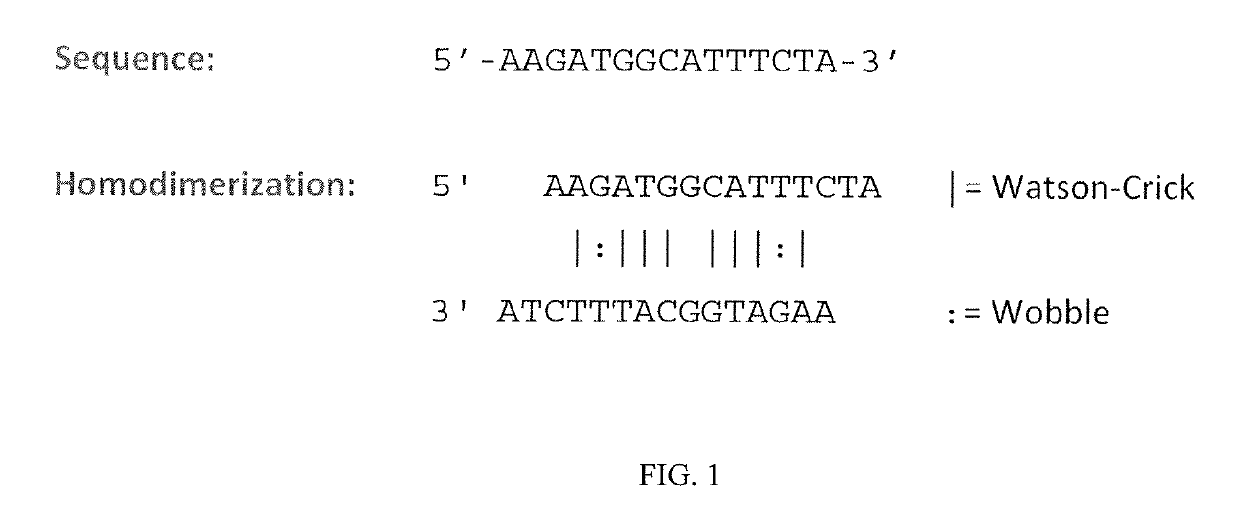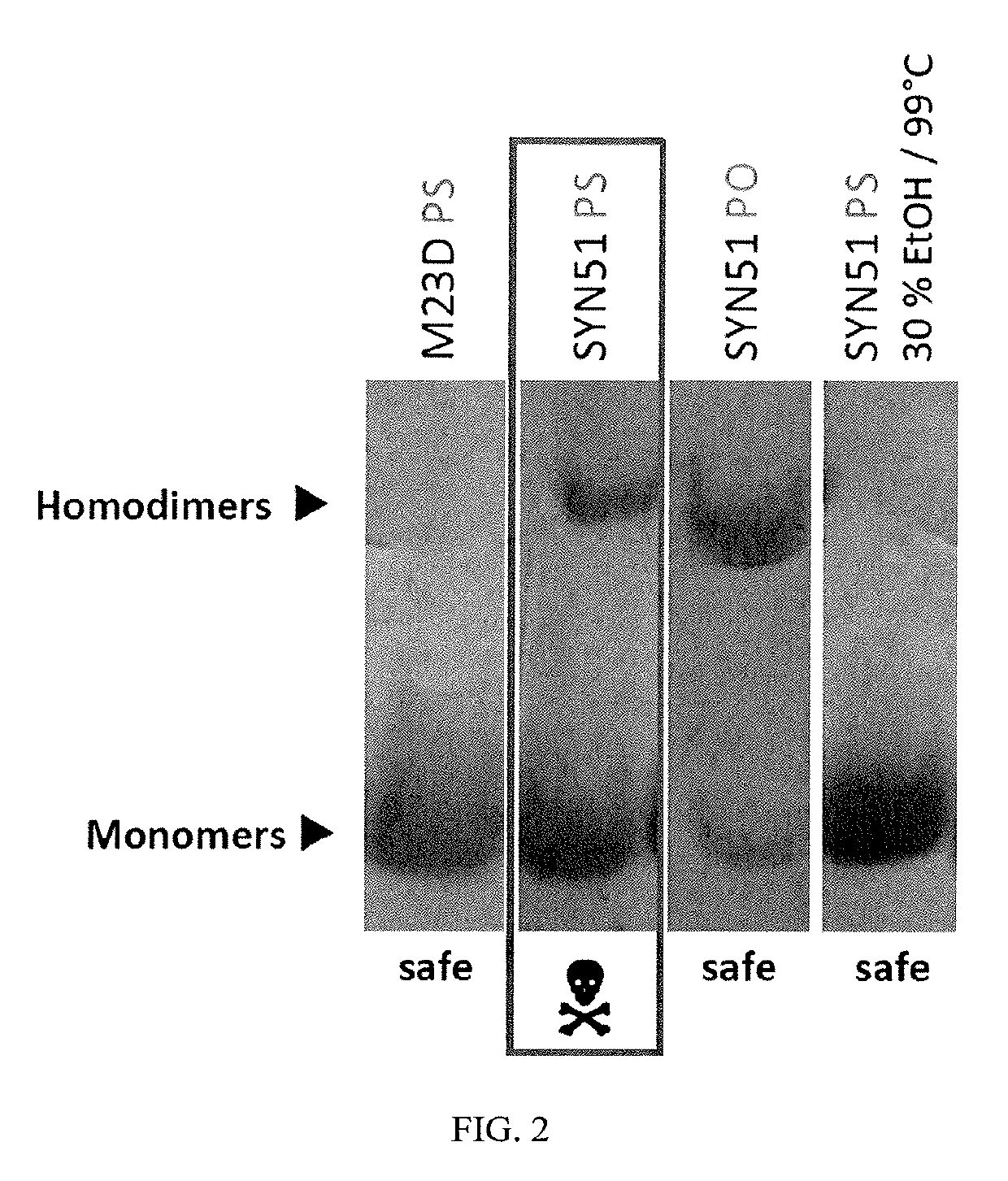Mixed Tricyclo-DNA, 2'-Modified RNA Oligonucleotide Compositions and Uses Thereof
a technology of oligonucleotide composition and mixed tricyclodna, which is applied in the field of mixed tricyclodna, 2′modified rna oligonucleotides, can solve the problems of oligonucleotide therapies for diseases based on antisense, sirna (dsrna), or anti-micro-rna approaches that have encountered hurdles to development, and achieve the effect of preventing sel
- Summary
- Abstract
- Description
- Claims
- Application Information
AI Technical Summary
Benefits of technology
Problems solved by technology
Method used
Image
Examples
example 1
icity of Phosphorothioate Oligonucleotides
[0428]Acute toxicity was demonstrated using the SYN51 tc-DNA oligonucleotide sequence shown in FIG. 1 (SEQ ID NO:68), which was synthesized both with all phosphorothioate linkages (“PS”) and with all phosphorodiester linkages (“PO”). The likely homodimerization motif of this sequence is also illustrated in FIG. 1.
[0429]Polyacrylamide-gel electrophoresis (PAGE) experiments were performed to detect self-multimers. The following chemicals were used: tris(hydroxymethyl)aminomethane (Tris), (TCI A0321); acetic acid (Merck 1.00063); acrylamide / Bis solution, 29:1 (40%, Serva 10680.01); tetramethylethylenediamine (TEMED, Sigma-Aldrich T9281); ammonium persulfate (Sigma-Aldrich 248614); and glycerol (Sigma-Aldrich G9012). Buffer solution A was prepared by dissolving 60 g of Tris in 200 mL of water. The pH is adjusted to 7.4 with glacial acetic acid (about 25-30 mL). The solution is diluted to 500 mL with water and stored at +4° C. Buffer solution B w...
example 2
ation of Multimers
[0436]A study was performed to explore multimer formation of tc-DNA oligonucleotides and identification of additional bands in gel electrophoresis experiments. As noted previously, it was observed that tc-DNA oligonucleotides with acute toxicity show an additional band in polyacrylamide gel electrophoresis experiments. It was proposed that this rather sharp band is a multimer of the oligonucleotide (e.g., duplex, trimer, or larger aggregate). The aim of this study is to identify the structure of this additional band. All oligonucleotides in this study are full tc-DNA and utilize full phosphorothioate (PS) internucleoside linkages (except for the PO group at the 5′-end).
[0437]The following oligonucleotides were measured by mass spectrometric (MS) analysis using an Orbitrap (ThermoFisher) instrument: SY-0206 (batch MK333, SYN 13-mer, purity 82%, toxic, SEQ ID NO:70); and SY-0210 (batch MK371, M23D 13-mer, purity 76%, non-toxic, SEQ ID NO:71). 14 μM solutions were pre...
example 3
and Characterization of Oligomeric Compounds
[0458]As described in the previous examples, a correlation exists between the toxicity of PS tc-DNA oligonucleotides and their ability to form multimers. Safe sequences (e.g., M23D) do not form self-multimers as identified by non-denaturing PAGE and SEC. It has been shown (e.g., in Example 1) that the disruption of a multimer structures leads to suppression of toxicity of an oligonucleotide that is otherwise toxic in its multimeric form. Other methods of disrupting self-multimer structures, including self-dimers, are known in the art (see, e.g., WO 2008 / 114262) but are not adequate at least for suppressing self-multimer formation and toxicity in antisense oligonucleotides comprising both tc-DNA and phosphorothioate linkages designed for use in treating exon-skipping diseases such as DMD. The novel approaches described herein to suppress self-multimer formation (as in the toxic SYN51) employ new chemistry introduced in the backbone in order...
PUM
| Property | Measurement | Unit |
|---|---|---|
| Fraction | aaaaa | aaaaa |
| Fraction | aaaaa | aaaaa |
| Fraction | aaaaa | aaaaa |
Abstract
Description
Claims
Application Information
 Login to View More
Login to View More - R&D
- Intellectual Property
- Life Sciences
- Materials
- Tech Scout
- Unparalleled Data Quality
- Higher Quality Content
- 60% Fewer Hallucinations
Browse by: Latest US Patents, China's latest patents, Technical Efficacy Thesaurus, Application Domain, Technology Topic, Popular Technical Reports.
© 2025 PatSnap. All rights reserved.Legal|Privacy policy|Modern Slavery Act Transparency Statement|Sitemap|About US| Contact US: help@patsnap.com



